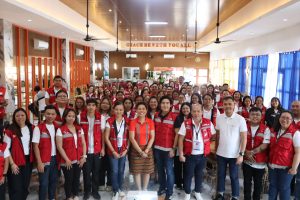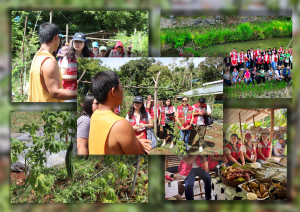The Department of Social Welfare and Development (DSWD) Project LAWA at BINHI of the Risk Resiliency Program (RRP) held an Experiential Learning Exchange Visit in the province of Siquijor to foster knowledge-sharing among field offices in Luzon and Visayas cluster.

Some 70 participants from the field offices of NCR, CAR, Region I, II, III, IV-A, IV-B, V, VI, VII, and VIII traveled to Lazi, Siquijor, for a four-day experiential exchange learning visit to share the best practices of each region and to show the active implementation of Project LAWA at BINHI in Siquijor province.
The activity included a courtesy call to Siquijor Provincial Governor Jake Vincent Villa to discuss implementation updates, strategies, and the continuous program implementation in the province. Hon. Villa expressed his full support for the program.
Moreover, the learning exchange included a series of talks about the overview and objectives of Project LAWA at BINHI. Disaster Response and Management Bureau (DRMB) Director Maria Isabel B. Lanada, in her talk, highlighted the greater calling of implementing Project LAWA at BINHI for its significant impact in reversing the effects of climate change.
“Unang una, seryoso ang pag init ng mundo. Ito ang buhay na mission at kontribusyon natin sa nag iisa nating tahanan. At ang nag iisa nating tahanan ay painit na ng painit. This is our mission. Binigyan tayo ng pagkakataon mapunta sa LAWA at BINHI, ibig sabihin gawin natin ang tama, gawin natin ang programa natin ng maayos para makatulong tayo sa bansa at sa mundo,” Director Lanada emphasized.
Meanwhile, DRMB Assistant Director Michael Christopher Mathay encouraged the participants to continue the best practices of each field office as the project will help the people in the long run.
“Let us continue what we are doing kasi ang dami nating natutulungan. This is not a short-term project but a long-term program na ibinibigay natin sa ating kababayan. Kaya let us remain dedicated at motivated para maibahagi ang serbisyong ito sa ating bansa,” Director Mathay expressed.
Learning Exchange Site Visit
Participants explore the communal gardens of Brgy. Tag-Ibo and Brgy. Canlasog and the Tilapia farm of Brgy. Capalasanan.
In Brgy. Tag-Ibo and Brgy. Canlasog, partner beneficiaries showcased the farm they are cultivating with vegetables and food crops such as eggplant, squash, chili, okra, etc. Moreover, they also shared the homemade fertilizer and insecticide they utilize to grow their crops.

Meanwhile, the water irrigation or Tilapiahan farm installed by partner beneficiaries in Brgy. Capalasanan serves as a source of living for fisher folk. Since its construction in July 2024, partner beneficiaries ensured its protection and maintenance as part of their livelihood.
While the groups continue to tend their communal garden, they also shared that one of their struggles in maintaining their farm is the source of water. With this, they installed a deep well and placed water barrels that they utilized to ensure the survival of the food crops.
In Siquijor province, all six local government units, Siquijor (the capital), Larena, Enrique Villanueva, Maria, Lazi, and San Juan, actively implement the Project LAWA at BINHI program.
Aside from food security, among the main reasons for the active implementation of the program in Siquijor is to mitigate the impacts of drought and flood brought about by El Nino and La Nina. ###